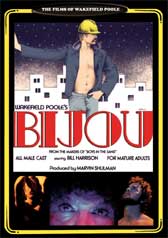 BIJOU
(1972)
BIJOU
(1972)Director: Wakefield Poole
Vinegar Syndrome
 BIJOU
(1972)
BIJOU
(1972)Vinegar Syndrome seem to be releasing the films of Wakefield Poole in reverse order (with BOYS IN THE SAND out this month), and one can see in the company's DVD of Poole's BIJOU some of the visual concepts and in-camera effects refined in BIBLE!
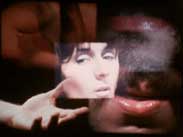
Virtually a silent film, BIJOU might be considered arty and pretentious by viewers looking for flat lighting, numerous hardcore close-ups, and money shots, but those looking for something else – especially after having reviewed some of Vinegar Syndrome's more deservedly obscure porn rarities – or predisposed to Poole via BIBLE!, his softcore send-up of Hollywood biblical epics, will find it a balletic celebration of the male body, as well as possibly the most technically innovative and visually stunning pornographic film of the seventies (quite an achievement on such a low budget when the Bob Guccione-produced multi-million dollar epic CALIGULA was a grainy, hazy mess). On his way home from work, a New York construction worker (Bill Harrison) witnesses a woman (Cassandra Hart) knocked down by a car (driven by director Wakefield Poole's business partner Marvin Shulman, who bought it with the profits from their earlier BOYS IN THE SAND). The construction worker pockets the woman's dropped purse and finds among the belongings a ticket to a place called "Bijou". He seeks out the hole-in-the-wall club which turns out to be a disorienting labyrinth of lights and mirrors in which the ostensibly straight construction worker embarks on a series of ritualized sexual encounters with other men culminating in an all-night orgy.
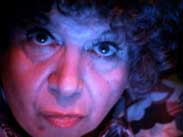 Poole
mentions in his commentary on the film that he had initially intended to follow
up BOYS IN THE SAND with a straight hardcore film about a fashion model going
to a club and being ravished by men – the Mitchell Brothers later took
that idea and made BEHIND THE GREEN DOOR – but had decided to stick to
gay erotica in the face of DEEP THROAT's obscenity prosecution. His concept
for BIJOU – stated in the commentary and the optional introduction –
was an abstract film which would mean different things to different people.
There are hints at alienation, loneliness, guilt, and religious oppression (perhaps
explaining the smile at the end); but the film might be just as abstract in
its ability to be appreciated as a work of erotica (more sensual than sexual)
or an underground film or just work of gay pornography that managed to achieve
something like the mainstream notice received by DEEP THROAT and other early
adult films that actually had their artistic merit debated (and sometimes exaggerated)
by film critics and scholars. The aforementioned track is worth a listen for
viewers who do attempt to ferret out an interpretation of the film's sketchy
narrative not because he reveals his interpretation but because he asks questions
of the protagonist's actions (as well as how the experience would have differed
had the woman who originally had the ticket attended "Bijou").
Poole
mentions in his commentary on the film that he had initially intended to follow
up BOYS IN THE SAND with a straight hardcore film about a fashion model going
to a club and being ravished by men – the Mitchell Brothers later took
that idea and made BEHIND THE GREEN DOOR – but had decided to stick to
gay erotica in the face of DEEP THROAT's obscenity prosecution. His concept
for BIJOU – stated in the commentary and the optional introduction –
was an abstract film which would mean different things to different people.
There are hints at alienation, loneliness, guilt, and religious oppression (perhaps
explaining the smile at the end); but the film might be just as abstract in
its ability to be appreciated as a work of erotica (more sensual than sexual)
or an underground film or just work of gay pornography that managed to achieve
something like the mainstream notice received by DEEP THROAT and other early
adult films that actually had their artistic merit debated (and sometimes exaggerated)
by film critics and scholars. The aforementioned track is worth a listen for
viewers who do attempt to ferret out an interpretation of the film's sketchy
narrative not because he reveals his interpretation but because he asks questions
of the protagonist's actions (as well as how the experience would have differed
had the woman who originally had the ticket attended "Bijou").
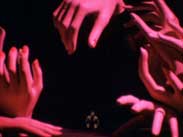
BIJOU was previously released by adult label Caballero – presumably using an old tape master – and then in a special edition by Mercury Releasing and gay-friendly label TLA Home Video in a two-disc set with Poole's BOYS IN THE SAND and MEN IN THE SAND, five short films, commentaries, and an interview with the director. I have not seen that set so I have no idea how the transfer compares to Vinegar Syndrome's progressive, fullscreen DVD from a 2K scan of the 16mm elements, but the current transfer is virtually spotless – apart from some in-camera scratches – with bold colors and no distortion in the saturated gel lighting. The Dolby Digital 1.0 mono track of this virtually silent film – besides the music score – is similarly free of any distracting damage.
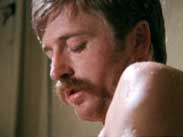 The
film can be watched with the aforementioned optional introduction by director
Wakefield Poole (1:04) or the film's audio commentary track, although I'm not
at all sure if this is a new track or if it has been carried over from the TLA
edition (Vinegar Syndrome's other commentary tracks for films previously released
on disc with commentary have been new). Going solo, Poole speaks with little
to no dead spots, with a bit of play-by-play and interpretation of the performers'
motivations but also a vivid recollection of his direction to the cast, how
the effects were achieved, and creating the club in his own apartment with a
lot of black felt, a few objet d'art and knick-knacks, and lighting equipment.
Besides the opening and closing titles, there are no opticals in the film, and
the scene in which the construction worker sees multiple screens of film projected
in front of him was achieved by pointing five projects onto black felt and filming
the results. Given how ridiculously-endowed Harrison was, it is hard to believe
Poole's claim that he cast the west coast actor without taking that into consideration
and first discovered it on-set while rolling the camera (Harrison apparently
went back to California after the film and formed his own adult film company
with his lover). Poole also discusses the on- and off-camera contributions of
own partner Peter Fisk and the casting of straight model Bill Cable (best known
if at all to most of us as the first victim in BASIC INSTINCT). Poole told the
other cast members not to touch Cable since he was straight knowing that someone
would break the rule and wanting to capture it on film (when he moment does
happen it is subtle and even touching rather than volatile). The commentary
track is very much like the film in its distanced appreciation of the male form
in motion (Poole even describes his films as a lot of undressing, dressing,
and walking around).
The
film can be watched with the aforementioned optional introduction by director
Wakefield Poole (1:04) or the film's audio commentary track, although I'm not
at all sure if this is a new track or if it has been carried over from the TLA
edition (Vinegar Syndrome's other commentary tracks for films previously released
on disc with commentary have been new). Going solo, Poole speaks with little
to no dead spots, with a bit of play-by-play and interpretation of the performers'
motivations but also a vivid recollection of his direction to the cast, how
the effects were achieved, and creating the club in his own apartment with a
lot of black felt, a few objet d'art and knick-knacks, and lighting equipment.
Besides the opening and closing titles, there are no opticals in the film, and
the scene in which the construction worker sees multiple screens of film projected
in front of him was achieved by pointing five projects onto black felt and filming
the results. Given how ridiculously-endowed Harrison was, it is hard to believe
Poole's claim that he cast the west coast actor without taking that into consideration
and first discovered it on-set while rolling the camera (Harrison apparently
went back to California after the film and formed his own adult film company
with his lover). Poole also discusses the on- and off-camera contributions of
own partner Peter Fisk and the casting of straight model Bill Cable (best known
if at all to most of us as the first victim in BASIC INSTINCT). Poole told the
other cast members not to touch Cable since he was straight knowing that someone
would break the rule and wanting to capture it on film (when he moment does
happen it is subtle and even touching rather than volatile). The commentary
track is very much like the film in its distanced appreciation of the male form
in motion (Poole even describes his films as a lot of undressing, dressing,
and walking around).
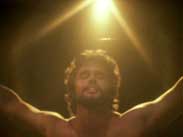
Instead of a video interview, "BIJOU Easter Sunday" (4:21) is Poole's anecdote about how the diverse reviews of the film spurned the head of Columbia University's psychology department to request a screening of the film at his apartment on Easter Sunday 1973 with his family – including grown son and daughter – in attendance. The reactions of the viewers were similarly diverse, with the son noting a sense of loneliness and oppression while the mother felt that the film had answered her curiosity about what the gay couple she plays bridge with does in bed. Film scholar Linda Williams – author of "Hard Core: Power, Pleasure and the Frenzy of the Visible" and "Screening Sex" – appears in a brief featurette (2:41) in which ties in an idea of pornography as a Utopian world where it's always bedtime – from Steve Marcus' "The Other Victorians" – to BIJOU's contrast between the construction worker's drab real world and the disorienting "separated utopia" of the club. It's a featurette that leaves one wanting more, and the film might have done with a longer analytical featurette or a second commentary track.
Also included is an interview with Wakefield Poole (3:14) extracted from a longer 1977 appearance on the New York cable access show "Emerald City" in which he tells host Frank O'Dowd that Al Goldstein labeled BOYS IN THE SAND the worst film of the year and BIJOU the best. He also discusses the film's in-camera effects and the film's sets (presumably there was more discussion of BOYS IN THE SAND since actor Casey Donovan also appears in this segment but says nothing here). As mentioned above, the auditions of the actors who appeared in the film were used in the projection scenes, but five of the performers who either dropped out or were not selected appear here in "Unused BIJOU Auditions" (14:09). In this silent segment – scored with music from the feature – bodybuilders and dancers strip, pose, and strut for the camera – not unlike the camera test footage included on Vinegar Syndrome's DVD of Poole's BIBLE! – some looking a bit silly for those of us with little context for appreciating seventies performance art and interpretive dance (one or two also seem annoyed or put off as they get dressed). Lastly, the disc also includes the film's theatrical trailer (4:01), also silent apart from music and probably suggesting a more straightforward if arty pornographic experience. (Eric Cotenas)